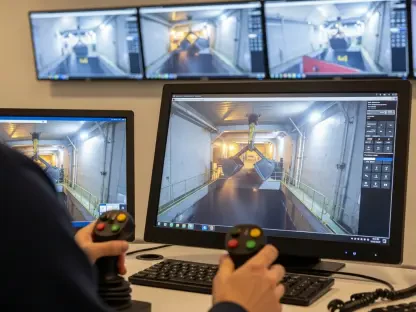AT&T is at the forefront of revolutionizing its network infrastructure, with a strong focus on Open RAN, AI, network automation, and the concept of digital twins. At the Mobile World Congress (MWC) in Barcelona, Yigal Elbaz, AT&T’s Senior Vice President of Technology and Network Services and Network CTO, shed light on these advancements. Elbaz detailed how the comprehensive strategies comprising the transition to Open RAN, the implementation of AI, efforts towards network automation, and the utilization of digital twins are set to transform the telecommunications landscape and underscore AT&T’s commitment to innovation and efficiency.
Open RAN Transition
AT&T’s Open RAN transition is progressing as planned, with the company aiming to modernize 70% of its 5G traffic on open hardware by late 2026 and complete the overall 5G network modernization by 2027. This ambitious undertaking encompasses key strategies designed to overhaul existing infrastructure and enhance network efficiency. The “Build and Swap” initiative is pivotal to this transition, involving the replacement of current Nokia radios while concurrently deploying new midband spectrum across thousands of sites. Importantly, the majority of this new hardware is designed to be “open capable,” which aligns with the broader goal of fostering an open and flexible network environment.
Another core element is the cloud RAN (Radio Access Network) foundation, a key driver of AT&T’s Open RAN strategy. The company has successfully integrated commercial traffic over cloud RAN for more than a year, utilizing solutions from providers like Ericsson. This foundational effort underscores AT&T’s commitment to cloud-based networking as part of its broader modernization strategy. These foundational changes are not just about replacing hardware, but about transforming the network infrastructure to be more adaptable, efficient, and prepared for future developments.
Utilization of Third-Party Radios
An essential component of AT&T’s Open RAN strategy is the incorporation of third-party radios from manufacturers such as Fujitsu, Mavenir, and Ericsson. This inclusive approach provides AT&T with increased flexibility and fosters innovation in network deployment, allowing the company to leverage the best available technologies from a variety of sources. The inclusion of third-party radios is about diversification, ensuring that the network is not reliant on a single supplier and can benefit from a wide array of technological advancements. This integration is not without its challenges, but it represents a significant shift towards a more open and flexible network ecosystem.
Transitioning to a unified management system is another significant stride in this modernization journey. The move from multiple, vendor-specific management systems to a single, streamlined system enhances operational efficiency and sets the stage for the integration of advanced AI and machine learning capabilities. This unified system approach eliminates redundancies and enables more effective resource management, paving the way for smarter, more responsive network operations. The unified management system is a clear indicator of how AT&T is rethinking its network infrastructure to be more cohesive and intelligent, aligning with broader technological trends toward automation and efficiency.
Leveraging Artificial Intelligence
Artificial intelligence has long been integral to AT&T’s network planning, playing a crucial role in effectively managing the complexity of both wireless networks and fiber planning. The application of AI in these areas is not a new development for AT&T; however, its role has become increasingly critical as the company moves towards an open network structure. The insights derived from AI tools are instrumental in optimizing network performance, predicting potential issues before they arise, and ensuring efficient resource allocation. AI’s contribution to network planning is a testament to how advanced analytics and machine learning can transform traditional operational models.
AI-based energy-saving tools represent another notable advancement, significantly contributing to energy efficiency within the network. AT&T has successfully implemented tools that achieve 30% energy savings, reflecting the potential of AI to drive not only operational efficiency but also sustainability. These tools analyze usage patterns and optimize energy consumption, reducing the overall carbon footprint of the network. The integration of AI in this context highlights how technology can be leveraged to meet both business objectives and environmental goals. AT&T’s focus on energy efficiency through AI is a model for how technology can create tangible benefits in operational sustainability.
Network Automation
Achieving autonomous networks remains a crucial goal for AT&T, as the company recognizes the transformative potential of full network automation. Utilizing TM Forum’s network autonomy framework, AT&T benchmarks its progression towards autonomy, acknowledging both the significant advancements made and the challenges posed by legacy infrastructure. Despite these challenges, AT&T has made notable progress, especially over the past few years, in automating various segments of its network. Network automation is about more than just efficiency; it’s about creating a network that can self-optimize, self-heal, and respond dynamically to changing conditions, thereby enhancing reliability and performance.
The integration of AI is crucial to achieving this level of network autonomy. AT&T’s partnerships with entities like Microsoft and Azure play a vital role in supporting robust data management within the company’s secure environment. These collaborations allow AT&T to leverage advanced AI and cloud computing resources, ensuring that its automation efforts are built on a foundation of cutting-edge technology. This synergy between AI and network automation underpins AT&T’s strategy for creating a next-generation network that is resilient, flexible, and capable of meeting the demands of the future. The vision of an autonomous network is gradually being realized through the thoughtful integration of advanced technologies.
The Network Digital Twin Concept
AT&T’s efforts to build a network digital twin demonstrate the company’s commitment to leveraging innovative technologies for network optimization and planning. The digital twin concept involves creating a virtual replica of physical network sites, aiding in a variety of operational tasks. Using drones to capture 3D imagery of these sites, AT&T can create detailed digital models that simplify site management and enhance precision in network planning. This approach allows for a comprehensive understanding of the network’s physical characteristics, enabling better decision-making regarding capacity expansion, new site development, and spectrum deployment.
The consolidation of these digital models feeds into AT&T’s broader network planning platform, providing a robust tool for strategic planning and operational efficiency. By building these digital twins, AT&T can simulate different scenarios and assess the potential impact of various changes before implementing them in the real world. This capability is invaluable for proactive network management and long-term planning. The digital twin concept is a clear example of how AT&T is harnessing advanced technology to improve every aspect of its network operations, from day-to-day management to strategic growth initiatives. It represents a fusion of physical and digital innovations that drive smarter network solutions.
Reflections on MWC Themes
AT&T is leading the charge in transforming its network infrastructure with a key emphasis on Open RAN, artificial intelligence, network automation, and digital twins. At the Mobile World Congress (MWC) in Barcelona, Yigal Elbaz, Senior Vice President of Technology and Network Services and Network CTO at AT&T, highlighted these innovations. Elbaz elaborated on how the transition to Open RAN, the integration of AI, advancements in network automation, and the adoption of digital twins are all critical elements that aim to reshape the telecommunications field. These efforts are indicators of AT&T’s strong dedication to modernizing its network and enhancing efficiency. AT&T believes that these technological advancements will not only increase operational efficiency but also improve the overall customer experience. As a result, the company is poised to set new standards in the telecom industry, showcasing its role at the cutting edge of digital transformation and innovation.









